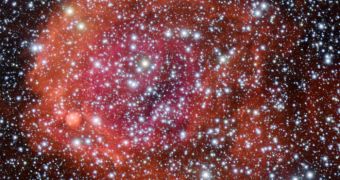A group of astronomers from the European Southern Observatory (ESO) release a brand-new image of stellar nurseries located around NGC 371, a star cluster contained within a neighboring galaxy, the Small Magellanic Cloud.
For this task, expert turned to the Very Large Telescope (VLT) ESO operated at the La Silla Observatory, in Chile. The instrument operated through interferometry, and is composed of four primary telescopes and four secondary ones.
At the center of the new image, the massive reddish bubble is in fact a HII region, an area of intense and recent stellar formation. It is composed largely of ionized hydrogen, which is the main ingredient for new stellar objects.
Stellar nurseries area massive clouds of molecular hydrogen, wherein smaller amounts of the gas – still pretty impressive by Earth standards – come together under the pull of gravity, around a central core.
Over time, as more mass is gathered, the clouds reach a critical mass beyond which they can no longer support their own weight. Once this happens, they suddenly implode, experiencing a huge degree of friction as this happens.
The heat that results from this process ignites the cold hydrogen gas, and kick-starts nuclear fusion within the cloud. If there is sufficient gas, then the new fireball will become a fully-fledged star.
This is precisely what happened in NGC 371, which featured massive amounts of the gas. However, recent observations have determined that the structure is now an open cluster surrounded by a nebula.
Experts explain that this is the final stage in the life of HII region. The structure will continue to function as a stellar nursery for a while, until insufficient gas remains to create a single new star.
All that will remain then will be an open star cluster that will be surrounded by a thick, nebula-like gas halo. NGC 371 is currently well on its way to becoming such a structure, having already exhausted most of its molecular hydrogen reserves.
This view, collected using the VLT FORS1 instrument, depicts hydrogen that is made to glow brightly by the ultraviolet radiation emissions of young, nearby stars. Solar winds are very strong on new stars, and then can really whip up a storm inside stellar nurseries.
It's not uncommon for such youngsters to disperse vast amounts of the gas from their birthplace, essentially curbing the rate at which nurseries form new cosmic fireballs.
“The data for this image were selected from the ESO archive by Manu Mejias as part of the Hidden Treasures competition,” which ended in 2010, experts with ESO say in a press release.

 14 DAY TRIAL //
14 DAY TRIAL //